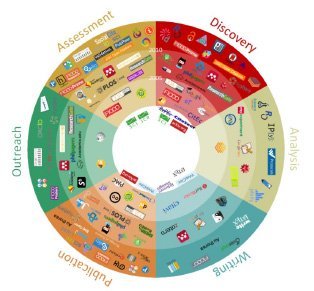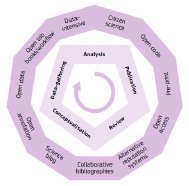Open Science has brought with it new possibilities for communication, access and information management that provide researchers with opportunities to work differently. In this article, we review the new workflows of researchers in this context.
Researcher’s workflow models
Kramer and Bosman (2015) have proposed a new workflow for the researcher in the digital context, structured in six phases: discovery, analysis, writing, publication, dissemination/dissemination, evaluation. In a more recent publication, Kramer and Bosman (2016) propose a preliminary, project planning phase, using tools such as Open Science Framework, F1000 Workspace.

Tools for the new researcher’s workflow in the digital context (Kramer y Bosman 2015)
Following these authors, we describe below the tasks and related tools for each of them:
- Discovery. This is a fundamental phase, since it offers the researcher the possibility of accessing precedents and keeps him/her up to date with advances in his/her field. Through search platforms such Google Scholar, through alerts in Google Scholar or databases (by keywords, topics or authors), through a source aggregator such as Feedly, or by following authors or publications on social networks (especially Twitter).
- Analysis. Analysis of data and selected evidences.
- Writing. Control of the bibliography (Zotero, Mendeley), drafting of the manuscript.
- Publication. Preprints, submission, peer review, publication, postprints.
- Outreach. Dissemination in the media and social networks, publication in open repositories (e-Lis, ScienceOpen), participation in outreach activities.
- In addition to traditional instruments such as the impact factor, since 2010 different indicators have been developed and popularized that take into account the new tasks to which researchers must dedicate time and effort: publication of data, blogs, peer reviews, publications and mentions in social networks, participation in dissemination activities, mentions in the media, etc. Thus, the following indicators can be considered: no. of views (publisher portal, Dryad),,, no. of downloads (publisher portal, SlideShare, Dryad), no. of shares (Facebook, Twitter), no. of reuses/adaptations (GitHub), no. of bookmarks (Mendeley, CiteULike, Delicious), no. of copies sold (library catalogs, publisher’s sales data), no. of comments generated (Twitter, Mendeley, blogs, publisher’s websites, Wikipedia, F1000). Tools: Altmetric, ImpactStory, Plum Analytics.
Kramer and Bosman subsequently (2018a) developed a version of the researcher’s workflow in the Open Access environment, summarized in the following figure:

Workflow of the researcher in the Open Science context (Kramer y Bosman 2018a)
This model is similar to the description of the research process in the Open Science context made by the European Commission:

Research process in the Open Science context (European Commission 2016, p. 36)
Kramer and Bosman (2018b) have also provided a series of recommendations for the researcher who wants to participate in Open Science, summarized in the following figure:

Cited sources:
KRAMER, B. & BOSMAN, J. (2015). 101 Innovations in Scholarly Communication – the Changing Research Workflow. Force 2015. Oxford. Available at: https://figshare.com/articles/101_Innovations_in_Scholarly_Communication_the_Changing_Research_Workflow/1286826
KRAMER, B. & BOSMAN, J. (2016). Academic social networks: the Swiss Army Knives of scholarly communication. Innovations in Scholarly Communication. Available at: https://101innovations.wordpress.com/2016/12/15/academic-social-networks-the-swiss-army-knives-of-scholarly-communication/
KRAMER, B. & BOSMAN, J. (2018a). Hypothetical Open Science workflow. Available at: https://101innovations.files.wordpress.com/2018/02/workflows-open-science.png
KRAMER, B. y BOSMAN, J. (2018b). Rainbow of open science practices. Available at: https://zenodo.org/record/1147025#.WuRN14hua00
